Teaching English Language Linguistics: Lesson Plan and Strategies
VerifiedAdded on 2023/06/03
|11
|2302
|362
AI Summary
This lesson plan revolves around teaching students on writing and speaking English and foreign languages. At the end of the lesson, students are expected to derive meaning with a given concept of word series. The lesson highly builds on students' prior learning experiences with the use of visualization aspects.
Contribute Materials
Your contribution can guide someone’s learning journey. Share your
documents today.
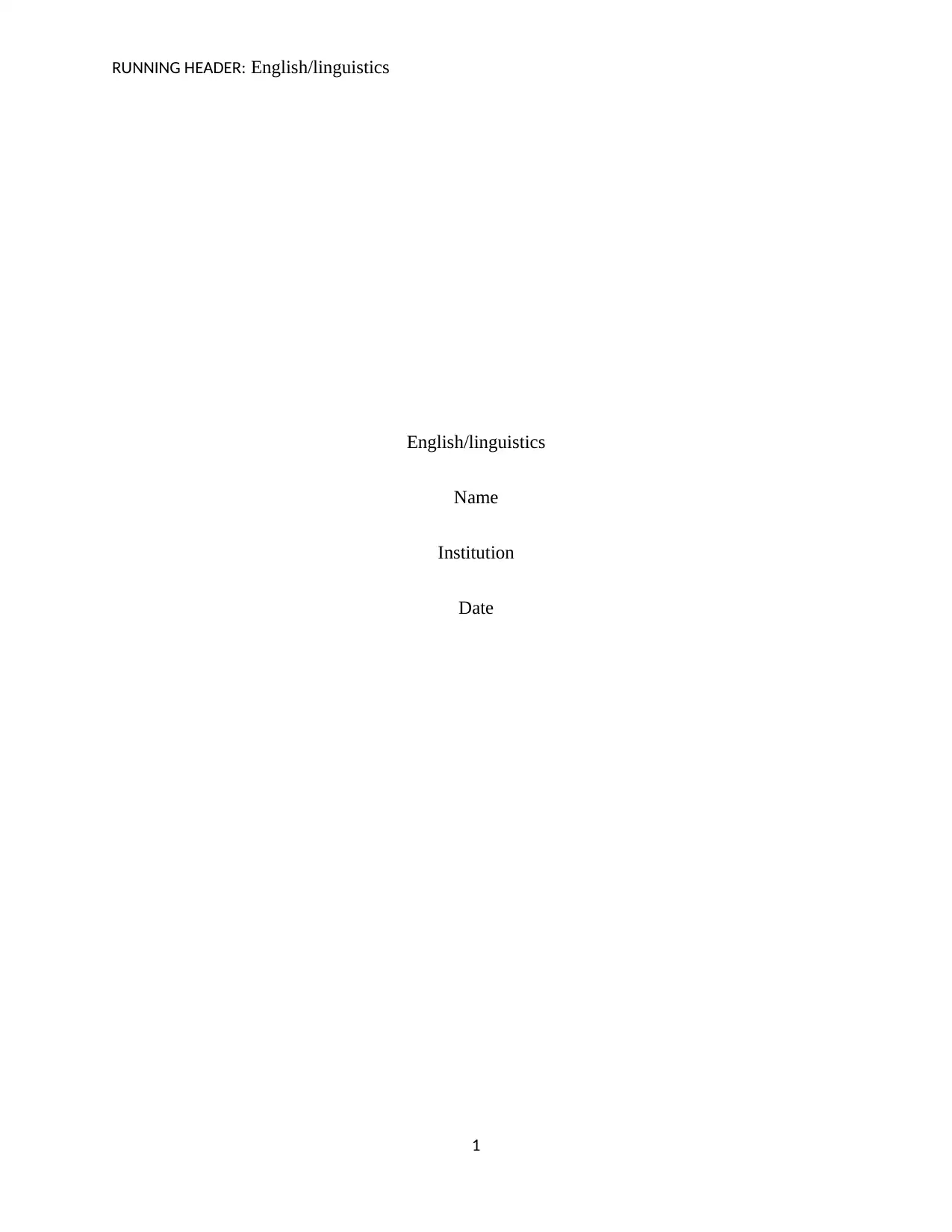
RUNNING HEADER: English/linguistics
English/linguistics
Name
Institution
Date
1
English/linguistics
Name
Institution
Date
1
Secure Best Marks with AI Grader
Need help grading? Try our AI Grader for instant feedback on your assignments.
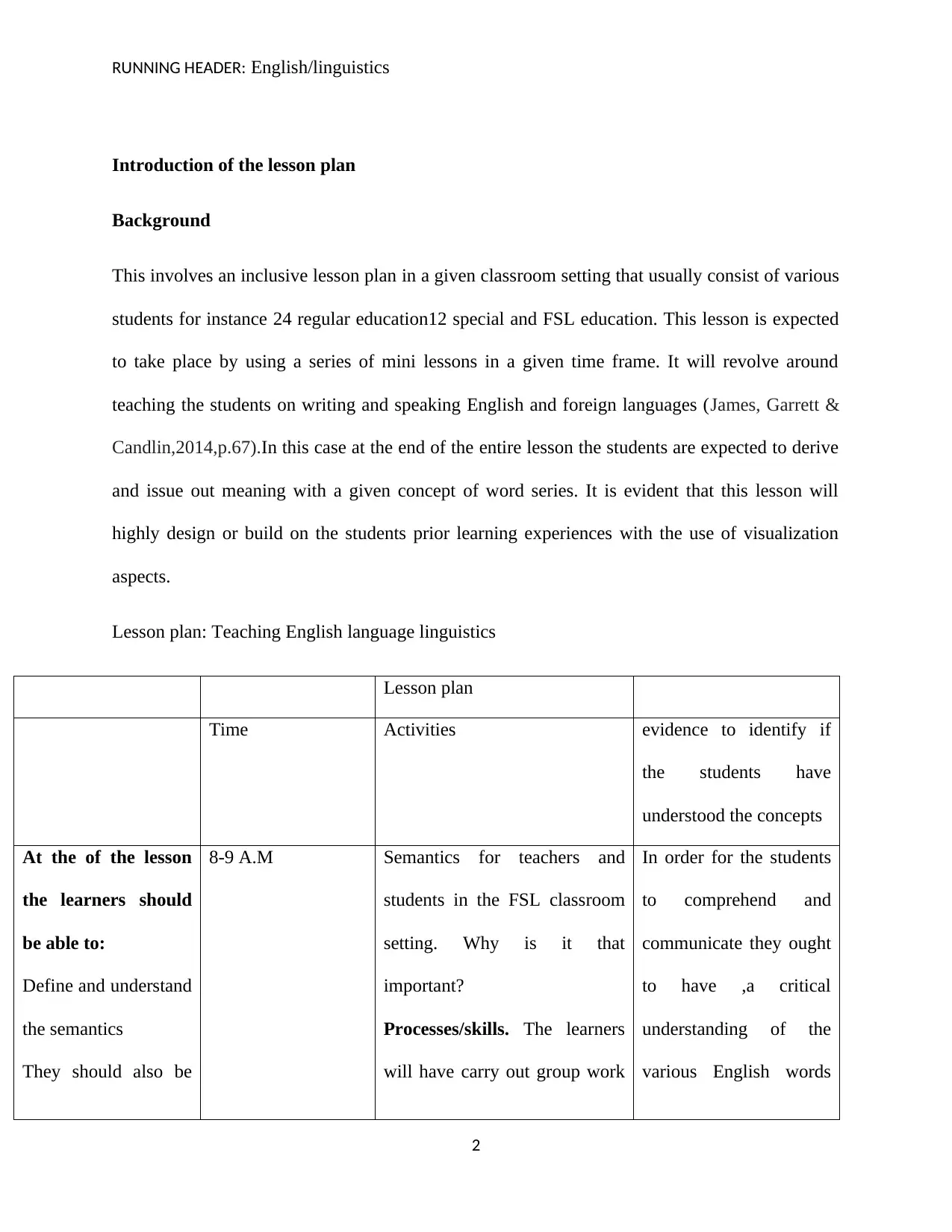
RUNNING HEADER: English/linguistics
Introduction of the lesson plan
Background
This involves an inclusive lesson plan in a given classroom setting that usually consist of various
students for instance 24 regular education12 special and FSL education. This lesson is expected
to take place by using a series of mini lessons in a given time frame. It will revolve around
teaching the students on writing and speaking English and foreign languages (James, Garrett &
Candlin,2014,p.67).In this case at the end of the entire lesson the students are expected to derive
and issue out meaning with a given concept of word series. It is evident that this lesson will
highly design or build on the students prior learning experiences with the use of visualization
aspects.
Lesson plan: Teaching English language linguistics
Lesson plan
Time Activities evidence to identify if
the students have
understood the concepts
At the of the lesson
the learners should
be able to:
Define and understand
the semantics
They should also be
8-9 A.M Semantics for teachers and
students in the FSL classroom
setting. Why is it that
important?
Processes/skills. The learners
will have carry out group work
In order for the students
to comprehend and
communicate they ought
to have ,a critical
understanding of the
various English words
2
Introduction of the lesson plan
Background
This involves an inclusive lesson plan in a given classroom setting that usually consist of various
students for instance 24 regular education12 special and FSL education. This lesson is expected
to take place by using a series of mini lessons in a given time frame. It will revolve around
teaching the students on writing and speaking English and foreign languages (James, Garrett &
Candlin,2014,p.67).In this case at the end of the entire lesson the students are expected to derive
and issue out meaning with a given concept of word series. It is evident that this lesson will
highly design or build on the students prior learning experiences with the use of visualization
aspects.
Lesson plan: Teaching English language linguistics
Lesson plan
Time Activities evidence to identify if
the students have
understood the concepts
At the of the lesson
the learners should
be able to:
Define and understand
the semantics
They should also be
8-9 A.M Semantics for teachers and
students in the FSL classroom
setting. Why is it that
important?
Processes/skills. The learners
will have carry out group work
In order for the students
to comprehend and
communicate they ought
to have ,a critical
understanding of the
various English words
2
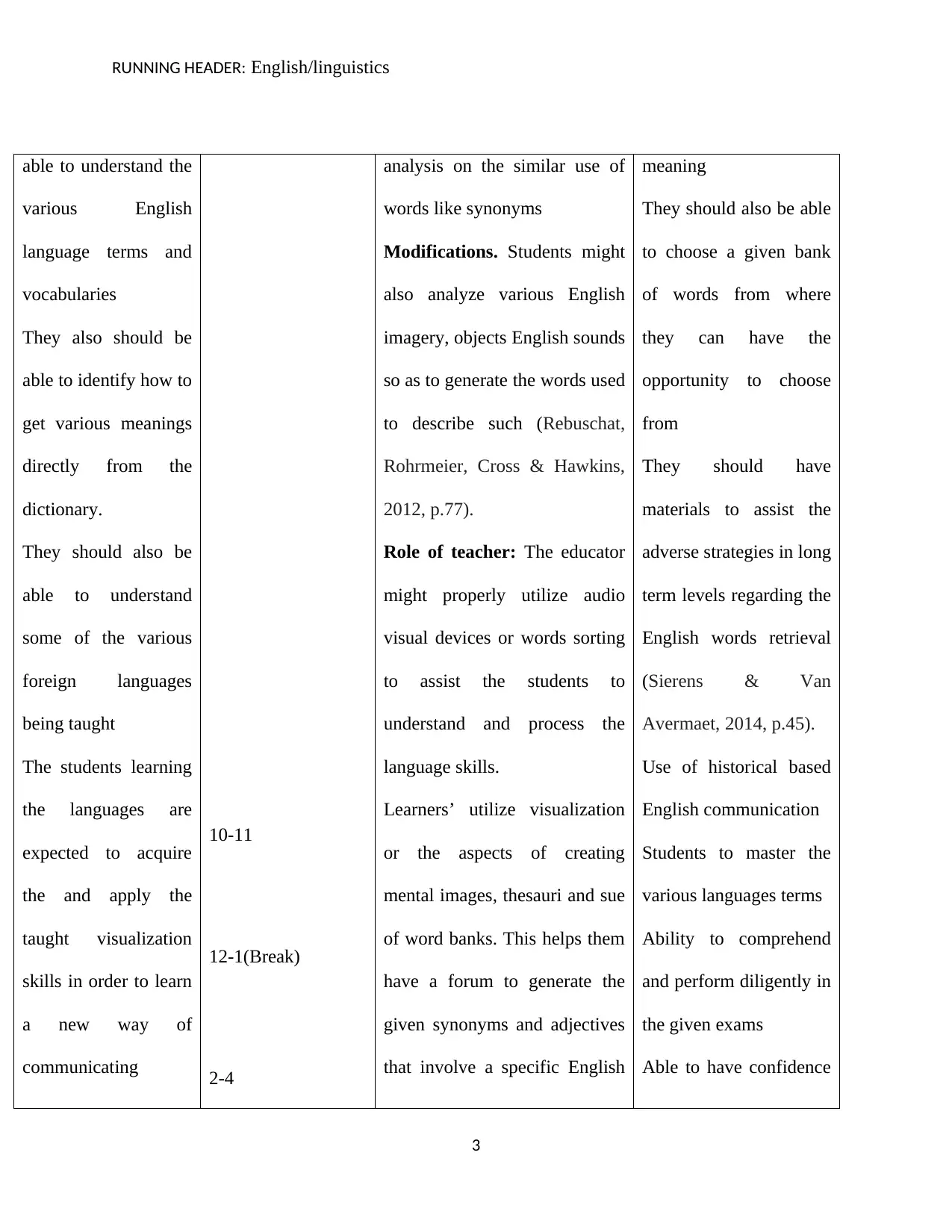
RUNNING HEADER: English/linguistics
able to understand the
various English
language terms and
vocabularies
They also should be
able to identify how to
get various meanings
directly from the
dictionary.
They should also be
able to understand
some of the various
foreign languages
being taught
The students learning
the languages are
expected to acquire
the and apply the
taught visualization
skills in order to learn
a new way of
communicating
10-11
12-1(Break)
2-4
analysis on the similar use of
words like synonyms
Modifications. Students might
also analyze various English
imagery, objects English sounds
so as to generate the words used
to describe such (Rebuschat,
Rohrmeier, Cross & Hawkins,
2012, p.77).
Role of teacher: The educator
might properly utilize audio
visual devices or words sorting
to assist the students to
understand and process the
language skills.
Learners’ utilize visualization
or the aspects of creating
mental images, thesauri and sue
of word banks. This helps them
have a forum to generate the
given synonyms and adjectives
that involve a specific English
meaning
They should also be able
to choose a given bank
of words from where
they can have the
opportunity to choose
from
They should have
materials to assist the
adverse strategies in long
term levels regarding the
English words retrieval
(Sierens & Van
Avermaet, 2014, p.45).
Use of historical based
English communication
Students to master the
various languages terms
Ability to comprehend
and perform diligently in
the given exams
Able to have confidence
3
able to understand the
various English
language terms and
vocabularies
They also should be
able to identify how to
get various meanings
directly from the
dictionary.
They should also be
able to understand
some of the various
foreign languages
being taught
The students learning
the languages are
expected to acquire
the and apply the
taught visualization
skills in order to learn
a new way of
communicating
10-11
12-1(Break)
2-4
analysis on the similar use of
words like synonyms
Modifications. Students might
also analyze various English
imagery, objects English sounds
so as to generate the words used
to describe such (Rebuschat,
Rohrmeier, Cross & Hawkins,
2012, p.77).
Role of teacher: The educator
might properly utilize audio
visual devices or words sorting
to assist the students to
understand and process the
language skills.
Learners’ utilize visualization
or the aspects of creating
mental images, thesauri and sue
of word banks. This helps them
have a forum to generate the
given synonyms and adjectives
that involve a specific English
meaning
They should also be able
to choose a given bank
of words from where
they can have the
opportunity to choose
from
They should have
materials to assist the
adverse strategies in long
term levels regarding the
English words retrieval
(Sierens & Van
Avermaet, 2014, p.45).
Use of historical based
English communication
Students to master the
various languages terms
Ability to comprehend
and perform diligently in
the given exams
Able to have confidence
3
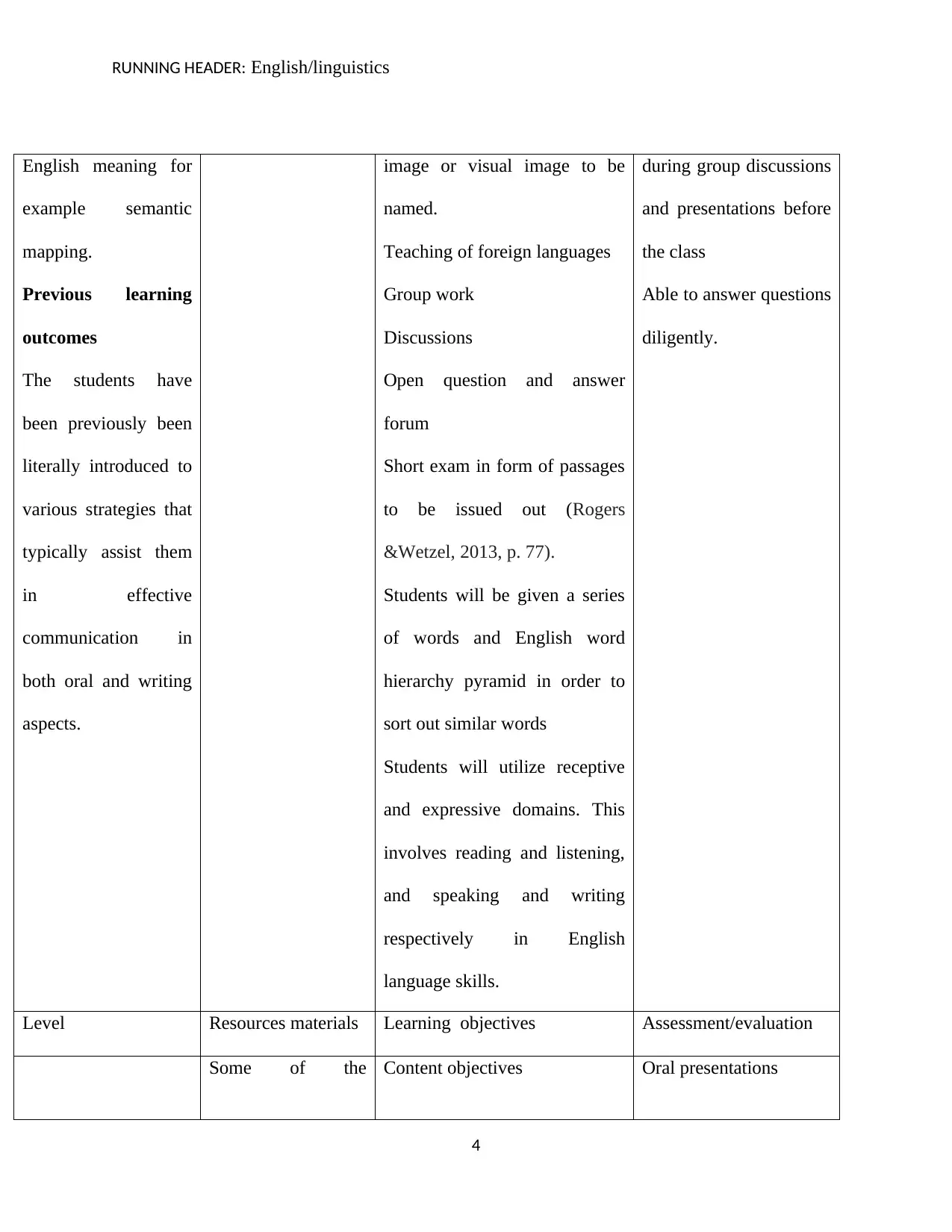
RUNNING HEADER: English/linguistics
English meaning for
example semantic
mapping.
Previous learning
outcomes
The students have
been previously been
literally introduced to
various strategies that
typically assist them
in effective
communication in
both oral and writing
aspects.
image or visual image to be
named.
Teaching of foreign languages
Group work
Discussions
Open question and answer
forum
Short exam in form of passages
to be issued out (Rogers
&Wetzel, 2013, p. 77).
Students will be given a series
of words and English word
hierarchy pyramid in order to
sort out similar words
Students will utilize receptive
and expressive domains. This
involves reading and listening,
and speaking and writing
respectively in English
language skills.
during group discussions
and presentations before
the class
Able to answer questions
diligently.
Level Resources materials Learning objectives Assessment/evaluation
Some of the Content objectives Oral presentations
4
English meaning for
example semantic
mapping.
Previous learning
outcomes
The students have
been previously been
literally introduced to
various strategies that
typically assist them
in effective
communication in
both oral and writing
aspects.
image or visual image to be
named.
Teaching of foreign languages
Group work
Discussions
Open question and answer
forum
Short exam in form of passages
to be issued out (Rogers
&Wetzel, 2013, p. 77).
Students will be given a series
of words and English word
hierarchy pyramid in order to
sort out similar words
Students will utilize receptive
and expressive domains. This
involves reading and listening,
and speaking and writing
respectively in English
language skills.
during group discussions
and presentations before
the class
Able to answer questions
diligently.
Level Resources materials Learning objectives Assessment/evaluation
Some of the Content objectives Oral presentations
4
Secure Best Marks with AI Grader
Need help grading? Try our AI Grader for instant feedback on your assignments.
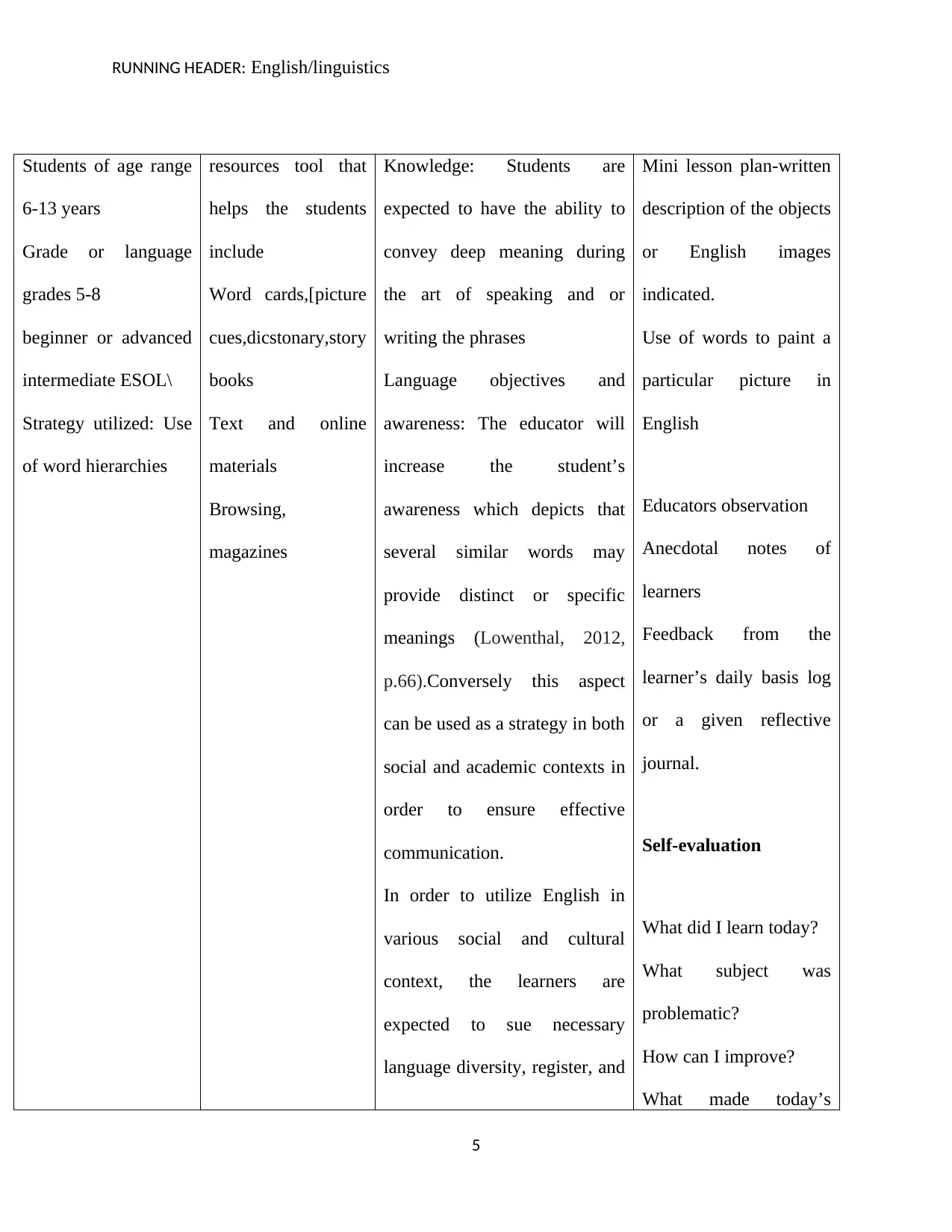
RUNNING HEADER: English/linguistics
Students of age range
6-13 years
Grade or language
grades 5-8
beginner or advanced
intermediate ESOL\
Strategy utilized: Use
of word hierarchies
resources tool that
helps the students
include
Word cards,[picture
cues,dicstonary,story
books
Text and online
materials
Browsing,
magazines
Knowledge: Students are
expected to have the ability to
convey deep meaning during
the art of speaking and or
writing the phrases
Language objectives and
awareness: The educator will
increase the student’s
awareness which depicts that
several similar words may
provide distinct or specific
meanings (Lowenthal, 2012,
p.66).Conversely this aspect
can be used as a strategy in both
social and academic contexts in
order to ensure effective
communication.
In order to utilize English in
various social and cultural
context, the learners are
expected to sue necessary
language diversity, register, and
Mini lesson plan-written
description of the objects
or English images
indicated.
Use of words to paint a
particular picture in
English
Educators observation
Anecdotal notes of
learners
Feedback from the
learner’s daily basis log
or a given reflective
journal.
Self-evaluation
What did I learn today?
What subject was
problematic?
How can I improve?
What made today’s
5
Students of age range
6-13 years
Grade or language
grades 5-8
beginner or advanced
intermediate ESOL\
Strategy utilized: Use
of word hierarchies
resources tool that
helps the students
include
Word cards,[picture
cues,dicstonary,story
books
Text and online
materials
Browsing,
magazines
Knowledge: Students are
expected to have the ability to
convey deep meaning during
the art of speaking and or
writing the phrases
Language objectives and
awareness: The educator will
increase the student’s
awareness which depicts that
several similar words may
provide distinct or specific
meanings (Lowenthal, 2012,
p.66).Conversely this aspect
can be used as a strategy in both
social and academic contexts in
order to ensure effective
communication.
In order to utilize English in
various social and cultural
context, the learners are
expected to sue necessary
language diversity, register, and
Mini lesson plan-written
description of the objects
or English images
indicated.
Use of words to paint a
particular picture in
English
Educators observation
Anecdotal notes of
learners
Feedback from the
learner’s daily basis log
or a given reflective
journal.
Self-evaluation
What did I learn today?
What subject was
problematic?
How can I improve?
What made today’s
5
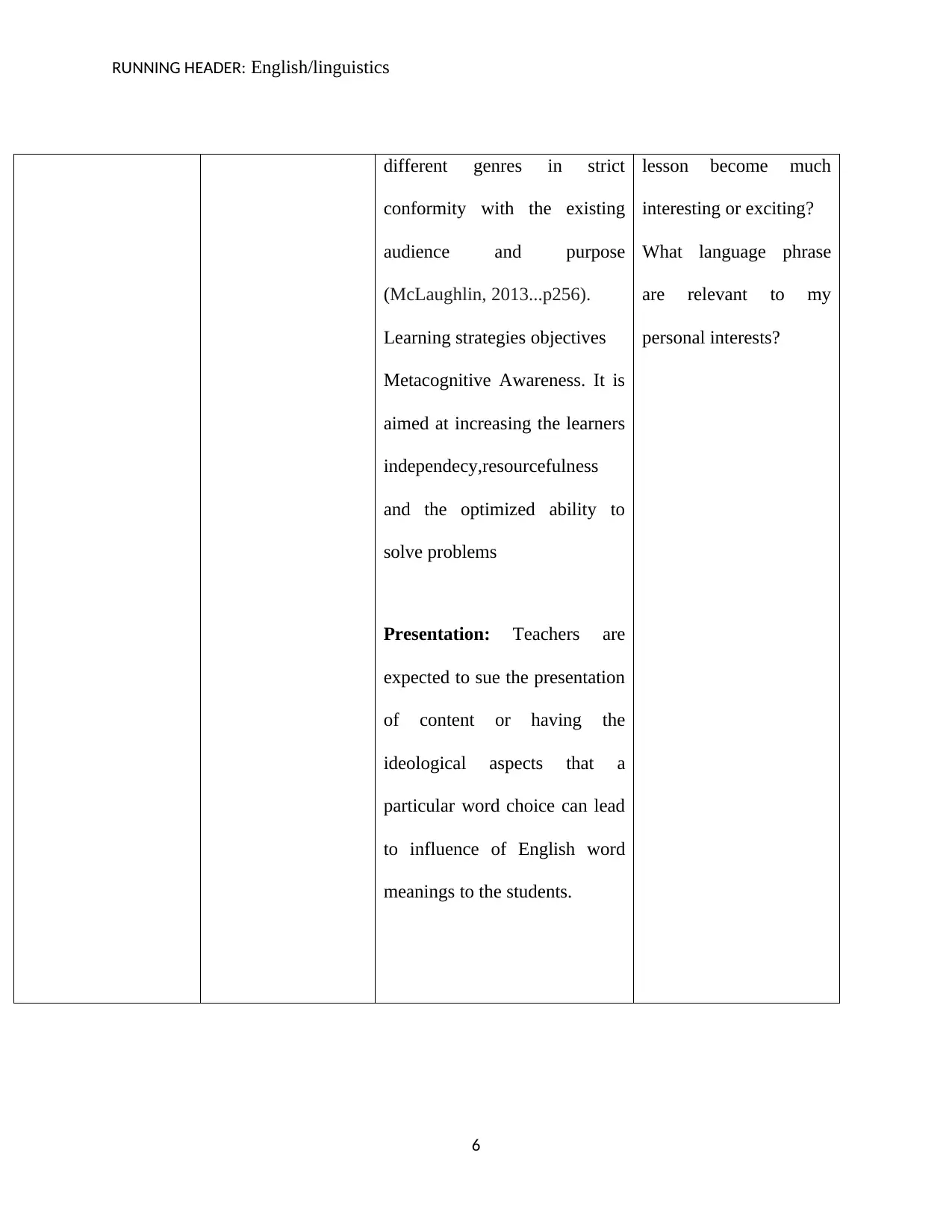
RUNNING HEADER: English/linguistics
different genres in strict
conformity with the existing
audience and purpose
(McLaughlin, 2013...p256).
Learning strategies objectives
Metacognitive Awareness. It is
aimed at increasing the learners
independecy,resourcefulness
and the optimized ability to
solve problems
Presentation: Teachers are
expected to sue the presentation
of content or having the
ideological aspects that a
particular word choice can lead
to influence of English word
meanings to the students.
lesson become much
interesting or exciting?
What language phrase
are relevant to my
personal interests?
6
different genres in strict
conformity with the existing
audience and purpose
(McLaughlin, 2013...p256).
Learning strategies objectives
Metacognitive Awareness. It is
aimed at increasing the learners
independecy,resourcefulness
and the optimized ability to
solve problems
Presentation: Teachers are
expected to sue the presentation
of content or having the
ideological aspects that a
particular word choice can lead
to influence of English word
meanings to the students.
lesson become much
interesting or exciting?
What language phrase
are relevant to my
personal interests?
6
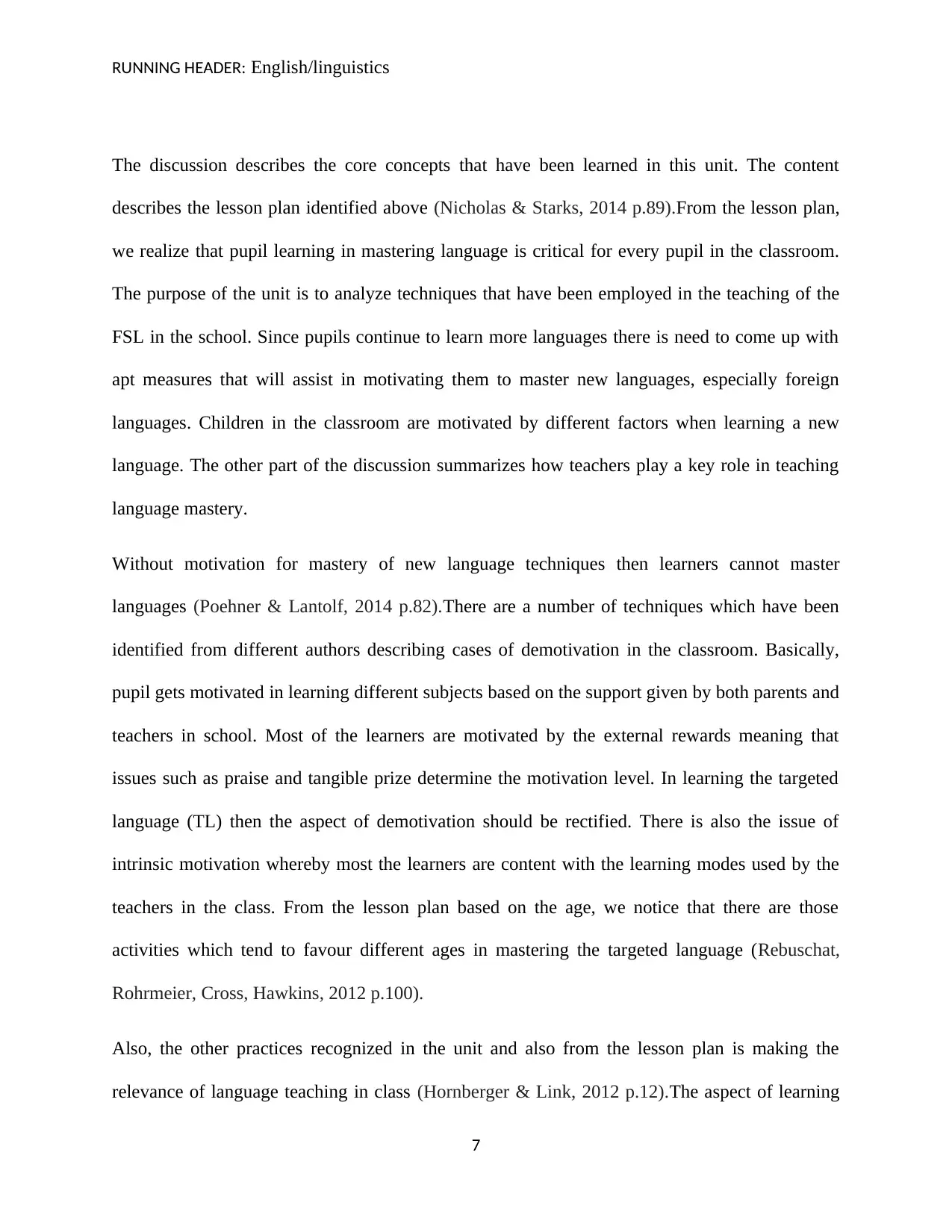
RUNNING HEADER: English/linguistics
The discussion describes the core concepts that have been learned in this unit. The content
describes the lesson plan identified above (Nicholas & Starks, 2014 p.89).From the lesson plan,
we realize that pupil learning in mastering language is critical for every pupil in the classroom.
The purpose of the unit is to analyze techniques that have been employed in the teaching of the
FSL in the school. Since pupils continue to learn more languages there is need to come up with
apt measures that will assist in motivating them to master new languages, especially foreign
languages. Children in the classroom are motivated by different factors when learning a new
language. The other part of the discussion summarizes how teachers play a key role in teaching
language mastery.
Without motivation for mastery of new language techniques then learners cannot master
languages (Poehner & Lantolf, 2014 p.82).There are a number of techniques which have been
identified from different authors describing cases of demotivation in the classroom. Basically,
pupil gets motivated in learning different subjects based on the support given by both parents and
teachers in school. Most of the learners are motivated by the external rewards meaning that
issues such as praise and tangible prize determine the motivation level. In learning the targeted
language (TL) then the aspect of demotivation should be rectified. There is also the issue of
intrinsic motivation whereby most the learners are content with the learning modes used by the
teachers in the class. From the lesson plan based on the age, we notice that there are those
activities which tend to favour different ages in mastering the targeted language (Rebuschat,
Rohrmeier, Cross, Hawkins, 2012 p.100).
Also, the other practices recognized in the unit and also from the lesson plan is making the
relevance of language teaching in class (Hornberger & Link, 2012 p.12).The aspect of learning
7
The discussion describes the core concepts that have been learned in this unit. The content
describes the lesson plan identified above (Nicholas & Starks, 2014 p.89).From the lesson plan,
we realize that pupil learning in mastering language is critical for every pupil in the classroom.
The purpose of the unit is to analyze techniques that have been employed in the teaching of the
FSL in the school. Since pupils continue to learn more languages there is need to come up with
apt measures that will assist in motivating them to master new languages, especially foreign
languages. Children in the classroom are motivated by different factors when learning a new
language. The other part of the discussion summarizes how teachers play a key role in teaching
language mastery.
Without motivation for mastery of new language techniques then learners cannot master
languages (Poehner & Lantolf, 2014 p.82).There are a number of techniques which have been
identified from different authors describing cases of demotivation in the classroom. Basically,
pupil gets motivated in learning different subjects based on the support given by both parents and
teachers in school. Most of the learners are motivated by the external rewards meaning that
issues such as praise and tangible prize determine the motivation level. In learning the targeted
language (TL) then the aspect of demotivation should be rectified. There is also the issue of
intrinsic motivation whereby most the learners are content with the learning modes used by the
teachers in the class. From the lesson plan based on the age, we notice that there are those
activities which tend to favour different ages in mastering the targeted language (Rebuschat,
Rohrmeier, Cross, Hawkins, 2012 p.100).
Also, the other practices recognized in the unit and also from the lesson plan is making the
relevance of language teaching in class (Hornberger & Link, 2012 p.12).The aspect of learning
7
Paraphrase This Document
Need a fresh take? Get an instant paraphrase of this document with our AI Paraphraser
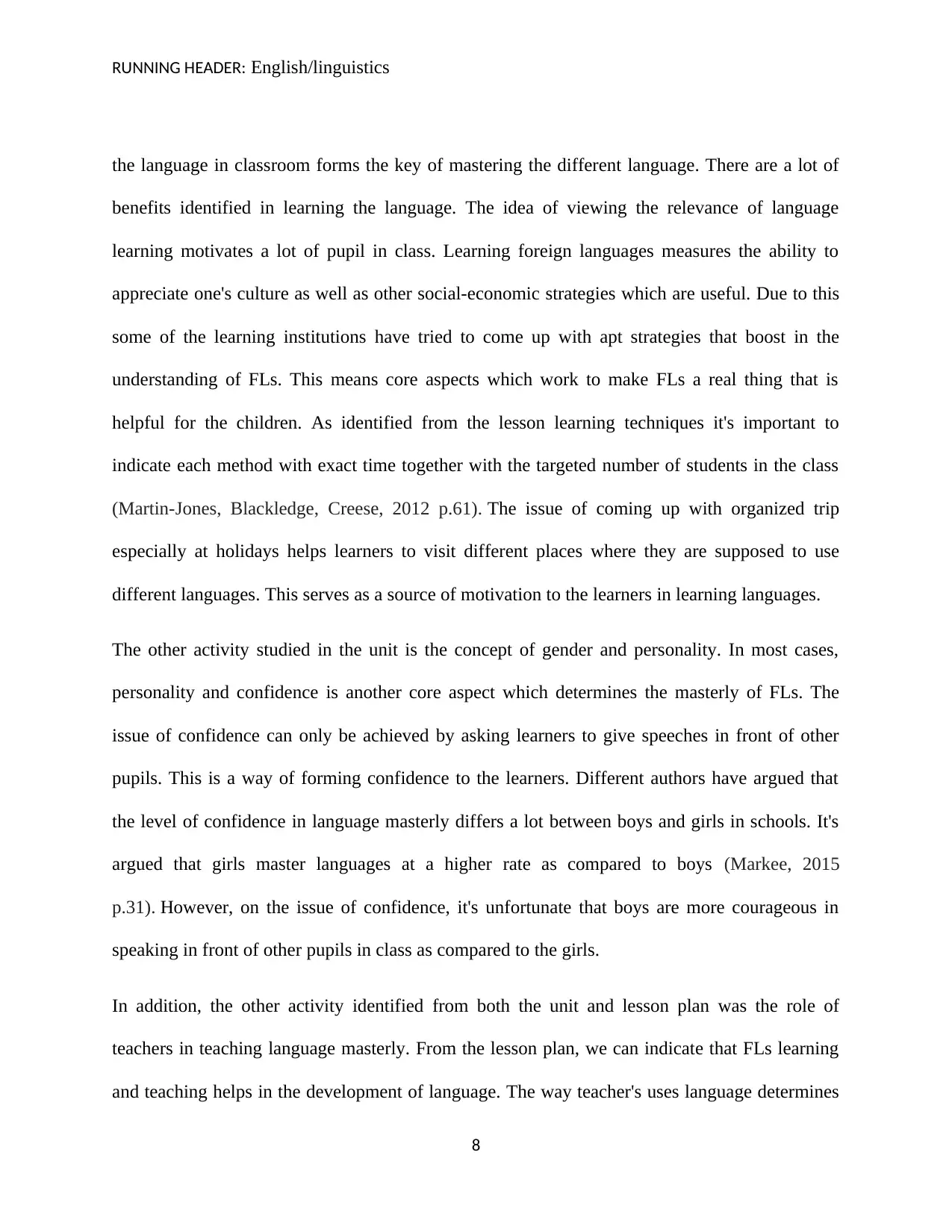
RUNNING HEADER: English/linguistics
the language in classroom forms the key of mastering the different language. There are a lot of
benefits identified in learning the language. The idea of viewing the relevance of language
learning motivates a lot of pupil in class. Learning foreign languages measures the ability to
appreciate one's culture as well as other social-economic strategies which are useful. Due to this
some of the learning institutions have tried to come up with apt strategies that boost in the
understanding of FLs. This means core aspects which work to make FLs a real thing that is
helpful for the children. As identified from the lesson learning techniques it's important to
indicate each method with exact time together with the targeted number of students in the class
(Martin-Jones, Blackledge, Creese, 2012 p.61). The issue of coming up with organized trip
especially at holidays helps learners to visit different places where they are supposed to use
different languages. This serves as a source of motivation to the learners in learning languages.
The other activity studied in the unit is the concept of gender and personality. In most cases,
personality and confidence is another core aspect which determines the masterly of FLs. The
issue of confidence can only be achieved by asking learners to give speeches in front of other
pupils. This is a way of forming confidence to the learners. Different authors have argued that
the level of confidence in language masterly differs a lot between boys and girls in schools. It's
argued that girls master languages at a higher rate as compared to boys (Markee, 2015
p.31). However, on the issue of confidence, it's unfortunate that boys are more courageous in
speaking in front of other pupils in class as compared to the girls.
In addition, the other activity identified from both the unit and lesson plan was the role of
teachers in teaching language masterly. From the lesson plan, we can indicate that FLs learning
and teaching helps in the development of language. The way teacher's uses language determines
8
the language in classroom forms the key of mastering the different language. There are a lot of
benefits identified in learning the language. The idea of viewing the relevance of language
learning motivates a lot of pupil in class. Learning foreign languages measures the ability to
appreciate one's culture as well as other social-economic strategies which are useful. Due to this
some of the learning institutions have tried to come up with apt strategies that boost in the
understanding of FLs. This means core aspects which work to make FLs a real thing that is
helpful for the children. As identified from the lesson learning techniques it's important to
indicate each method with exact time together with the targeted number of students in the class
(Martin-Jones, Blackledge, Creese, 2012 p.61). The issue of coming up with organized trip
especially at holidays helps learners to visit different places where they are supposed to use
different languages. This serves as a source of motivation to the learners in learning languages.
The other activity studied in the unit is the concept of gender and personality. In most cases,
personality and confidence is another core aspect which determines the masterly of FLs. The
issue of confidence can only be achieved by asking learners to give speeches in front of other
pupils. This is a way of forming confidence to the learners. Different authors have argued that
the level of confidence in language masterly differs a lot between boys and girls in schools. It's
argued that girls master languages at a higher rate as compared to boys (Markee, 2015
p.31). However, on the issue of confidence, it's unfortunate that boys are more courageous in
speaking in front of other pupils in class as compared to the girls.
In addition, the other activity identified from both the unit and lesson plan was the role of
teachers in teaching language masterly. From the lesson plan, we can indicate that FLs learning
and teaching helps in the development of language. The way teacher's uses language determines
8
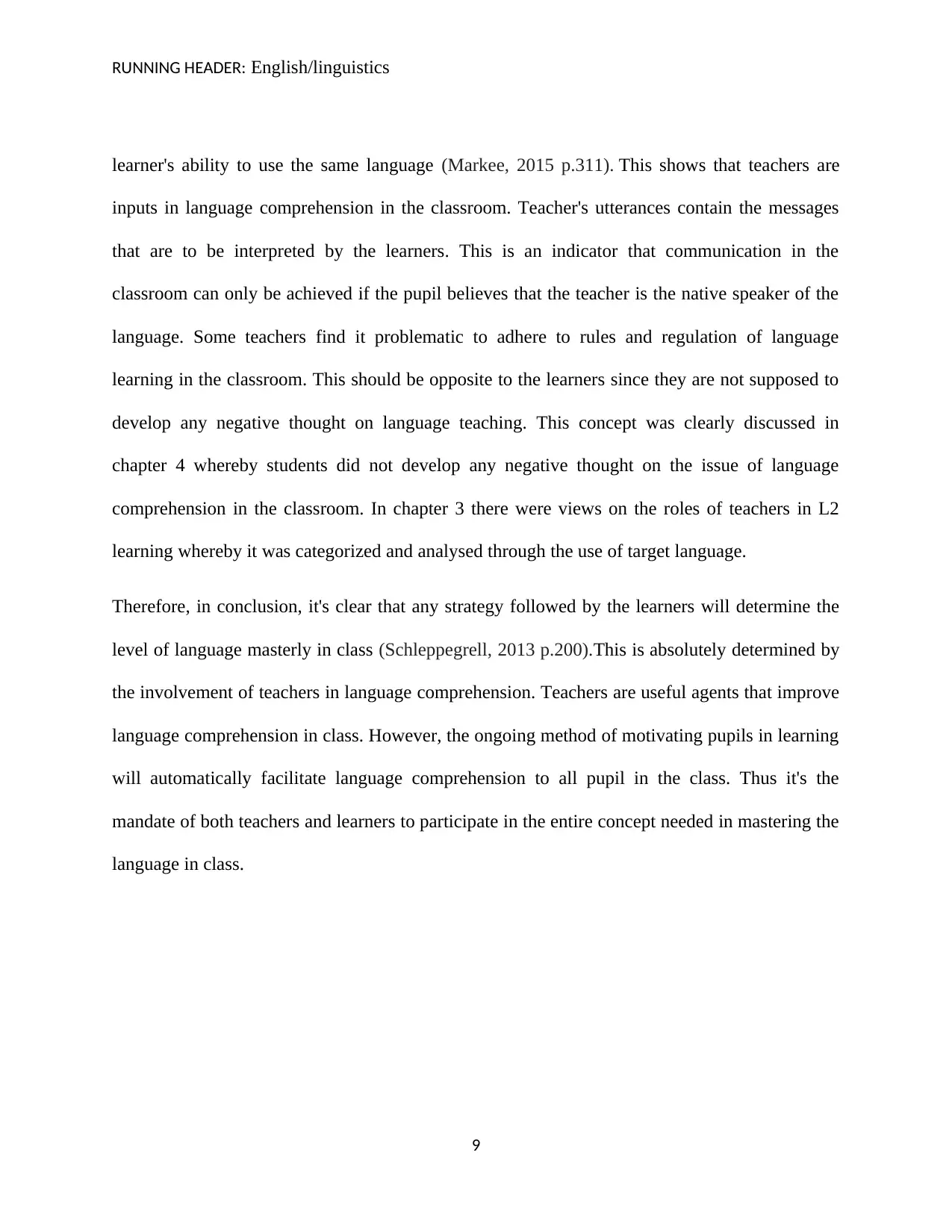
RUNNING HEADER: English/linguistics
learner's ability to use the same language (Markee, 2015 p.311). This shows that teachers are
inputs in language comprehension in the classroom. Teacher's utterances contain the messages
that are to be interpreted by the learners. This is an indicator that communication in the
classroom can only be achieved if the pupil believes that the teacher is the native speaker of the
language. Some teachers find it problematic to adhere to rules and regulation of language
learning in the classroom. This should be opposite to the learners since they are not supposed to
develop any negative thought on language teaching. This concept was clearly discussed in
chapter 4 whereby students did not develop any negative thought on the issue of language
comprehension in the classroom. In chapter 3 there were views on the roles of teachers in L2
learning whereby it was categorized and analysed through the use of target language.
Therefore, in conclusion, it's clear that any strategy followed by the learners will determine the
level of language masterly in class (Schleppegrell, 2013 p.200).This is absolutely determined by
the involvement of teachers in language comprehension. Teachers are useful agents that improve
language comprehension in class. However, the ongoing method of motivating pupils in learning
will automatically facilitate language comprehension to all pupil in the class. Thus it's the
mandate of both teachers and learners to participate in the entire concept needed in mastering the
language in class.
9
learner's ability to use the same language (Markee, 2015 p.311). This shows that teachers are
inputs in language comprehension in the classroom. Teacher's utterances contain the messages
that are to be interpreted by the learners. This is an indicator that communication in the
classroom can only be achieved if the pupil believes that the teacher is the native speaker of the
language. Some teachers find it problematic to adhere to rules and regulation of language
learning in the classroom. This should be opposite to the learners since they are not supposed to
develop any negative thought on language teaching. This concept was clearly discussed in
chapter 4 whereby students did not develop any negative thought on the issue of language
comprehension in the classroom. In chapter 3 there were views on the roles of teachers in L2
learning whereby it was categorized and analysed through the use of target language.
Therefore, in conclusion, it's clear that any strategy followed by the learners will determine the
level of language masterly in class (Schleppegrell, 2013 p.200).This is absolutely determined by
the involvement of teachers in language comprehension. Teachers are useful agents that improve
language comprehension in class. However, the ongoing method of motivating pupils in learning
will automatically facilitate language comprehension to all pupil in the class. Thus it's the
mandate of both teachers and learners to participate in the entire concept needed in mastering the
language in class.
9
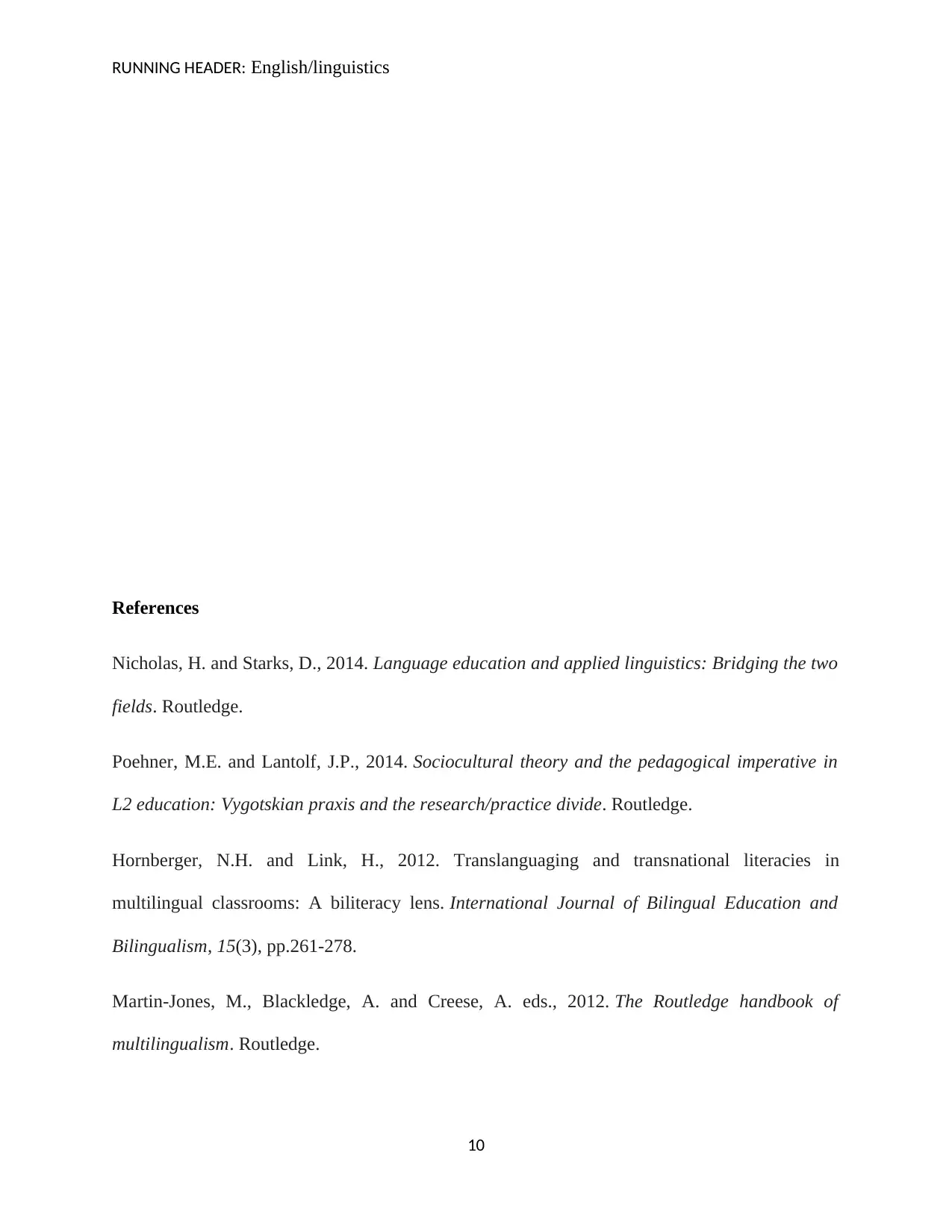
RUNNING HEADER: English/linguistics
References
Nicholas, H. and Starks, D., 2014. Language education and applied linguistics: Bridging the two
fields. Routledge.
Poehner, M.E. and Lantolf, J.P., 2014. Sociocultural theory and the pedagogical imperative in
L2 education: Vygotskian praxis and the research/practice divide. Routledge.
Hornberger, N.H. and Link, H., 2012. Translanguaging and transnational literacies in
multilingual classrooms: A biliteracy lens. International Journal of Bilingual Education and
Bilingualism, 15(3), pp.261-278.
Martin-Jones, M., Blackledge, A. and Creese, A. eds., 2012. The Routledge handbook of
multilingualism. Routledge.
10
References
Nicholas, H. and Starks, D., 2014. Language education and applied linguistics: Bridging the two
fields. Routledge.
Poehner, M.E. and Lantolf, J.P., 2014. Sociocultural theory and the pedagogical imperative in
L2 education: Vygotskian praxis and the research/practice divide. Routledge.
Hornberger, N.H. and Link, H., 2012. Translanguaging and transnational literacies in
multilingual classrooms: A biliteracy lens. International Journal of Bilingual Education and
Bilingualism, 15(3), pp.261-278.
Martin-Jones, M., Blackledge, A. and Creese, A. eds., 2012. The Routledge handbook of
multilingualism. Routledge.
10
Secure Best Marks with AI Grader
Need help grading? Try our AI Grader for instant feedback on your assignments.
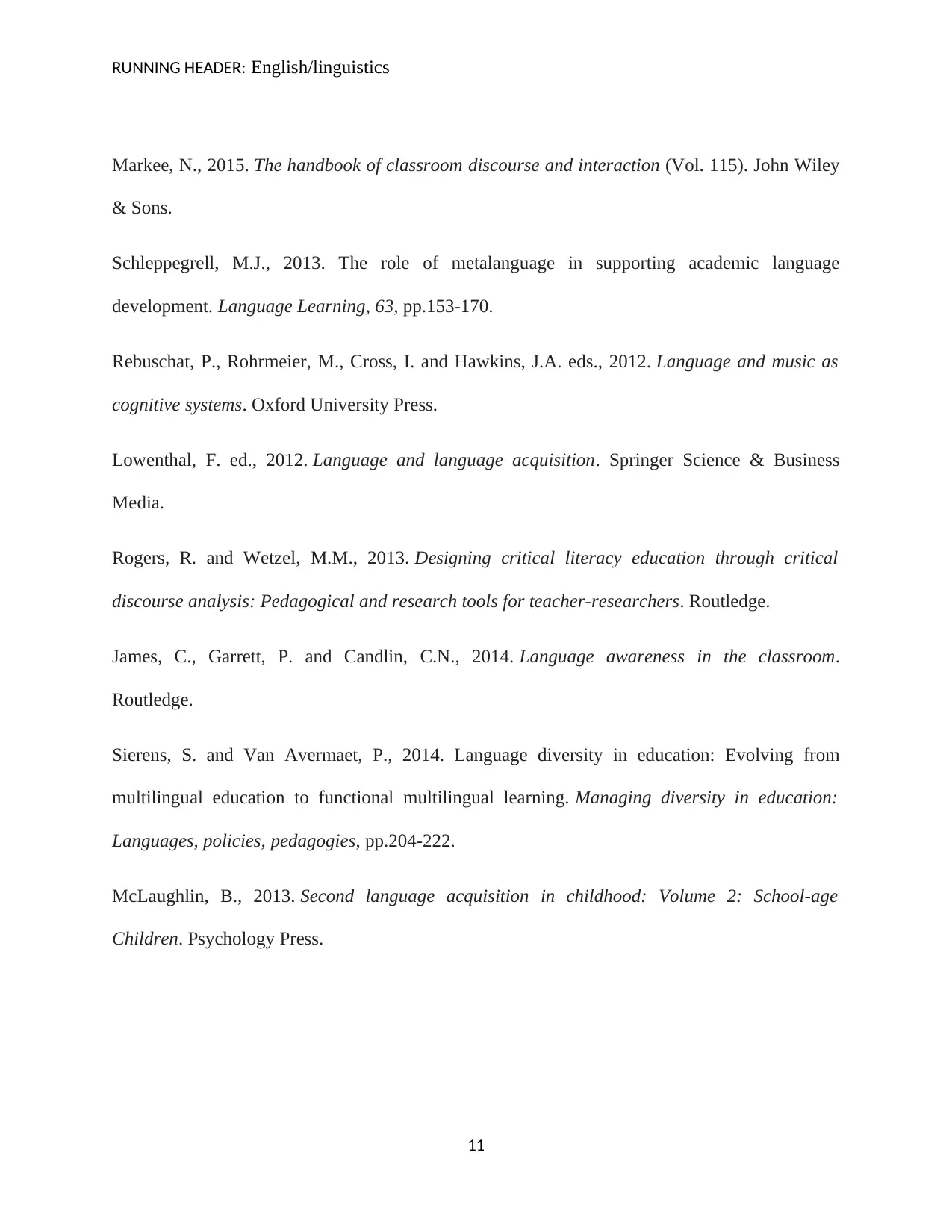
RUNNING HEADER: English/linguistics
Markee, N., 2015. The handbook of classroom discourse and interaction (Vol. 115). John Wiley
& Sons.
Schleppegrell, M.J., 2013. The role of metalanguage in supporting academic language
development. Language Learning, 63, pp.153-170.
Rebuschat, P., Rohrmeier, M., Cross, I. and Hawkins, J.A. eds., 2012. Language and music as
cognitive systems. Oxford University Press.
Lowenthal, F. ed., 2012. Language and language acquisition. Springer Science & Business
Media.
Rogers, R. and Wetzel, M.M., 2013. Designing critical literacy education through critical
discourse analysis: Pedagogical and research tools for teacher-researchers. Routledge.
James, C., Garrett, P. and Candlin, C.N., 2014. Language awareness in the classroom.
Routledge.
Sierens, S. and Van Avermaet, P., 2014. Language diversity in education: Evolving from
multilingual education to functional multilingual learning. Managing diversity in education:
Languages, policies, pedagogies, pp.204-222.
McLaughlin, B., 2013. Second language acquisition in childhood: Volume 2: School-age
Children. Psychology Press.
11
Markee, N., 2015. The handbook of classroom discourse and interaction (Vol. 115). John Wiley
& Sons.
Schleppegrell, M.J., 2013. The role of metalanguage in supporting academic language
development. Language Learning, 63, pp.153-170.
Rebuschat, P., Rohrmeier, M., Cross, I. and Hawkins, J.A. eds., 2012. Language and music as
cognitive systems. Oxford University Press.
Lowenthal, F. ed., 2012. Language and language acquisition. Springer Science & Business
Media.
Rogers, R. and Wetzel, M.M., 2013. Designing critical literacy education through critical
discourse analysis: Pedagogical and research tools for teacher-researchers. Routledge.
James, C., Garrett, P. and Candlin, C.N., 2014. Language awareness in the classroom.
Routledge.
Sierens, S. and Van Avermaet, P., 2014. Language diversity in education: Evolving from
multilingual education to functional multilingual learning. Managing diversity in education:
Languages, policies, pedagogies, pp.204-222.
McLaughlin, B., 2013. Second language acquisition in childhood: Volume 2: School-age
Children. Psychology Press.
11
1 out of 11
Related Documents
Your All-in-One AI-Powered Toolkit for Academic Success.
+13062052269
info@desklib.com
Available 24*7 on WhatsApp / Email
![[object Object]](/_next/static/media/star-bottom.7253800d.svg)
Unlock your academic potential
© 2024 | Zucol Services PVT LTD | All rights reserved.





